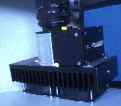 15k
15k
 14k
14k
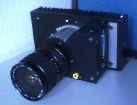 11k
11k
This Page is no longer updated. See my new Supernova page if you are interested, or look at my CCD camera page if you want to see the problems I had and still have in the attempts to image deep-sky objects.
After much frustration concerning my old CCD-camera and the results I obtained with it, I decided to build a new camera on my own. The adventure started on Nov. 10th, 1997 when I ordered the electronic parts. Soldering work was done within a week without problems, but the mechanical parts were a much harder job to do. First light was on Feb. 1st, 14h 22m MEZ.
The camera is a CB245 from the electronics side but I decided to replace the liquid coolant system with a forced air design, which is a more mobile solution, although I know that the original liquid cooler is able to reach a lower chip temperature. For this reason I replaced the original peletier cooler by a larger, more powerful one, and added a second stage on top of it, to reach a lower chip temp resulting in a lower dark current.
Three different views off the camera:
The second image the camera made is this one of my self:
For support I thank Prof. M. Roemer, H.Bauch, B.Thinius and K.Boedewig who did the work on the lathe.
First outdoor tests were made on Feb. 3. Allthough the moon was there and polar-alignment was bad, it was possible to image some deep sky objects. First was M42 which is of course quit bright, but then I was astonished to see
M51 with spiral arms with 8 second integrations in the softwares finder mode. The results shown here were done at 25 second integrations at F/10. Not overwhelming, mainly because ice was forming on the chip when it cooled down.
Meanwhile I have made the LDC-modification, which reduces dark current by more than an oder of magnitude. First results follow. All images were exposed for 120 seconds and a dark field was subtracted. The new LDC was on and a focal reducer was used.
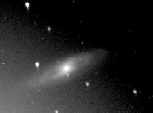 Spiral galaxy M65, 1.5 x zoomed detail, jpeg, 5k
Spiral galaxy M65, 1.5 x zoomed detail, jpeg, 5k
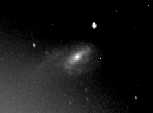 Spiral galaxy M66, 1.5 x zoomed detail, jpeg, 5k
Spiral galaxy M66, 1.5 x zoomed detail, jpeg, 5k
In the night of April 23, I had several problems in a first test, far from home and normal electricity. The following image of NGC 4565 is a raw image of 120-second exp. time, without further processing. The bright core, over-exposed in most images, stands out clearly. The dust lanes are also well visible. The image should be compared to my drawing from the same galaxy, from 1997.
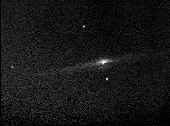 Edge-on galaxy NGC 4565, jpeg, 14k
Edge-on galaxy NGC 4565, jpeg, 14k
Two images from May 15.
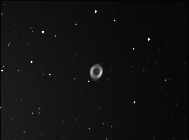 ,M57 Ring nebula in Lyra, jpeg, 9k
,M57 Ring nebula in Lyra, jpeg, 9k
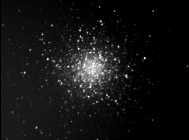 ,M13 Globular cluster in Hercules, jpeg, 18k
,M13 Globular cluster in Hercules, jpeg, 18k
Two images from May 19.
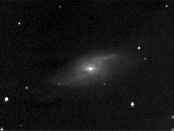 ,M106 Galaxy in Canes Venatici, jpeg, 18k
,M106 Galaxy in Canes Venatici, jpeg, 18k
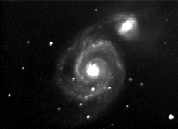 ,M51 Galaxy in Canes Venatici, jpeg, 19k
,M51 Galaxy in Canes Venatici, jpeg, 19k
This is supernova 1998S which was detected on March 3, 1998. It appeared as an mag 12.5 star in NGC 3877 in UMa. The second image of the same galaxy without the SN is from the DSS.
This Page is no longer updated. See my new Supernova
page if you are interested, or look at my CCD camera page if you want to see the problems I had and still have in the attempts to image deep-sky objects.
SUPERNOVA 1998S IN NGC 3877
W.-d. Li, University of California at Berkeley, forwards a
report from C. Li, Beijing Astronomical Observatory (BAO), that
Zhou Wan has found an apparent supernova (unfiltered mag 15.2) on
CCD images obtained with the 0.60-m BAO telescope on Mar. 3 UT as
part of the BAO Supernova Survey (cf. IAUC 6612). A confirming CCD
observation made with the Katzman Automatic Imaging Telescope
(KAIT) of Lick Observatory by the Lick Supernova Survey (cf. IAUC
6627) indicates that the object has brightened to unfiltered mag
about 13.5 on Mar. 4.3 UT. SN 1998S is located at R.A. =
11h46m06s, Decl. = +47o29'.0 (equinox 2000.0; based on the KAIT
image), which is 16" west and 46" south of the nucleus of NGC 3877.
As the object is embedded in the galaxy, the BAO magnitude was
obtained from a subtracted image. SN 1998S is not present in
images of the same field taken prior to Mar. 3.
A. V. Filippenko and E. C. Moran, University of California at
Berkeley, obtained a very-high-resolution (0.015 nm) echelle
spectrogram of SN 1998S on Mar. 4 with the Keck-1 telescope. The
probable presence of broad H-alpha emission superposed on a
featureless continuum suggests that this is a type-II supernova.
The following information appeared in International Astronomical Union Circular(IUAC) 6830:
A low-resolution Keck-2 spectrum shows that the type-II SN 1998S is peculiar; the spectrum contains prominent H and He emission lines
superposed on a featureless blue continuum. In many respects, the spectrum resembles that of the type-IIn...... the lines have multiple
components, including a very narrow (unresolved) one that is probably produced by flash- ionized circumstellar gas. This object might
become very luminous at radio and x-ray wavelengths, due to strong interaction between the ejecta and circumstellar material.......
For further information refer to Astronomical Headlines
This image was made in the night from 24th to 25th of March. It resulted from the addition of four 45 second integrations where the dark current had been removed in a first step.
Telescope was my CG11 at F/6.3. Polar alignment was not well done and the problem with frost on the chip still remains, that means cooling of the CCD was also bad. The heaven at my near city location was covered with thin clouds in this night and the outside temperature was some degrees below 0 deg Celsius.
The next image was made on 26th of March, just after midnight (local time). It resulted from the addition of nineteen 35 second integrations where the dark current had been removed in a first step.
Telescope was my CG11 at F/6.3. Polar alignment was a problem as in the night before and again cooling of the CCD was done with one stage only. The heaven this night was slightly better than in the night before and the outside temperature was -2 deg Celsius.
This image is from 1st of April, just after midnight (local time). 17 images were used, each individual resulted from a 70 second integration. The sky conditions were quite bad. Fog reduced the limiting magnitude of the faintest stars to mag 4 for the unaided eye and the outside temperature was quite warm (12 deg Celsius) so that cooling of the CCD was a problem.
A light curve can be downloaded from here.
Some data about NGC 3877:
Magnitude: 11.9
RA: 11h 46m 8.0s
Dec: +47d 29' 39" Epoch 2000
Size (mins) 5.5 x 1.3
Constellation Ursa Major
Description in Deep Sky Field Guide to Uranometria 2000: Bright middle, no bright nucleus but star superimposed very near, two main knotty arms
de Vaucouleurs classification: SA(s)c: II-III
In English: Spiral, S-shaped (uncertain) luminosity class II-III .
The best images I have found so far is this CfA SN image
Or this one, made with the 1.2-meter reflector at the Fred Lawrence Whipple Observatory outside Tucson, Arizona.
This image was made in the night from 18th to 19th of May. Thirteen images were combined. For details see SN1998aq from the same night. The Supernova has recognizable faded if you compare it to the previous images from March. The image is zoomed by 2. Some degradation is caused by dew on Schmidt-Plate.
Wow, what a night, 3 Supernovae in one night. The first SN1998bu can be found below, the next SN1998S follows here, the third, SN1998aq again below.
The image was made in the night from 19th to 20th of May. 22 images were combined in the usual way. The Supernova has recognizable faded if you compare it to the previous images from March. Zoomed by 2.
A lightcurve at this Page
This is my third Supernova. Here is the original announcement form IAU-Circular06876.html:
SUPERNOVA 1998aq IN NGC 3982
Magnitude obtained by D. Hanzl, Brno, Czech Republic (0.4-m
reflector + CCD + V filter; GSC comparison stars): Apr. 14.834 UT,
14.3.
The above image was made in the night from 18th to 19th of May. It resulted from the addition of 18 70 second integrations where the dark current had been removed in a first step. The image is zoomed by 2.
Telescope was my CG11 at F/6.3. Polar alignment was done with the help of my new polar axis finder and the problem with frost on the chip is solved now. The heaven at my location was hazy this night and the outside temperature was 9 degrees Celsius.
Better conditions in this night, 19th to 20th of May. Improved cooling of the CCD, 22 images, zoomed by 2.
More details and finder charts on David Bishops homepage, see below.
This is my second Supernova. Here is the original announcement form IAU-Circular06899.html:
SUPERNOVA 1998bu IN NGC 3368
Mirko Villi, Forli, Italy, reports his discovery on CCD images
taken on May 9.9 UT of an apparent supernova (mag about 13) located
about 60" north of the center of NGC 3368 = M96. Villi notes that
a previous CCD image taken on Apr. 21.9 shows no object in this
position, neither is anything visible on several atlases of galaxy
images. S. Nakano, Sumoto, Japan, reports that M. Aoki (Toyama)
has obtained a CCD image of SN 1998bu (V = 11.8) on May 10.618 with
a 0.43-m reflector in bad weather conditions, from which the
following precise position was measured: R.A. = 10h46m46s.03, Decl.
= +11o50'07".1 (equinox 2000.0), which is 4".3 east and 55".3 north
of the center of NGC 3368. No star was visible on previous frames
of this galaxy taken by Aoki. B. A. Skiff, Lowell Observatory,
reports that he viewed the apparent supernova on May 10.33 UT at
visual mag perhaps 12.0-12.5. D. Hanzl, Brno, Czech Republic,
reports that he imaged SN 1998bu on May 10.835 at V = 12.37 with a
0.40-m reflector + CCD; he gave the offset as 49" north of the
galaxy's center.
Finder charts and more on
this SN-Page of David Bishop
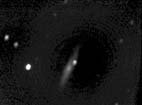 SN1998S in NGC3877, 03/24/98, jpeg, 3k
SN1998S in NGC3877, 03/24/98, jpeg, 3k
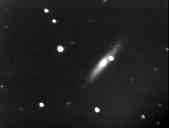 SN1998S in NGC3877, 03/25/98,jpeg, 3k
SN1998S in NGC3877, 03/25/98,jpeg, 3k
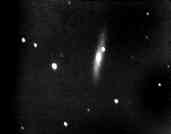 SN1998S in NGC3877, 04/01/98,jpeg, 4k
SN1998S in NGC3877, 04/01/98,jpeg, 4k
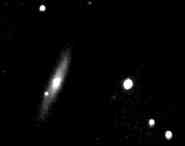 SN1998s in NGC 3877, 05/18/98,jpeg, 6k
SN1998s in NGC 3877, 05/18/98,jpeg, 6k
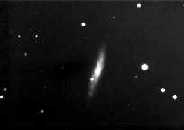 SN1998s in NGC 3877, 05/19/98,jpeg, 6k
SN1998s in NGC 3877, 05/19/98,jpeg, 6k
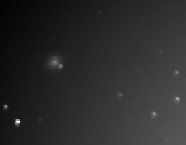 SN1998aq in NGC 3982, 05/18/98,jpeg, 6k
SN1998aq in NGC 3982, 05/18/98,jpeg, 6k
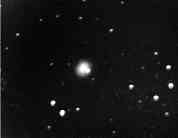 SN1998aq in NGC 3982, 05/19/98,jpeg, 6k
SN1998aq in NGC 3982, 05/19/98,jpeg, 6k
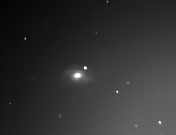 SN1998bu in M96, 05/15/98,jpeg, 6k
SN1998bu in M96, 05/15/98,jpeg, 6k
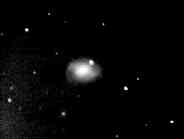 SN1998bu in M96, 05/19/98,jpeg, 6k
SN1998bu in M96, 05/19/98,jpeg, 6k